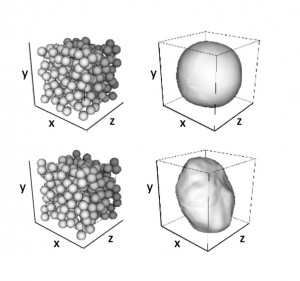The image below shows “before” and “after” configurations of a collection of spherical particles. The particles are initially arranged homogeneously. One goal of our theoretical work is to describe the elements of suspension structure that are needed to describe deformation, without tracking the position and velocity of every particle. To achieve this goal, we use a “structure surface,” shown to the right of the particles. This surface corresponds qualitatively to the inverse of the distance any randomly chosen test particle would move before striking another particle. It is initially a sphere, because initially the suspension exhibits no directional preference, or is isotropic. Very soon after the flow starts, however, the structure becomes non-isotropic as particles are moved together in some directions and moved apart in others. This image was prepared by Jonathan Stickel, who received his Ph.D. in Chemical Engineering in 2006.

